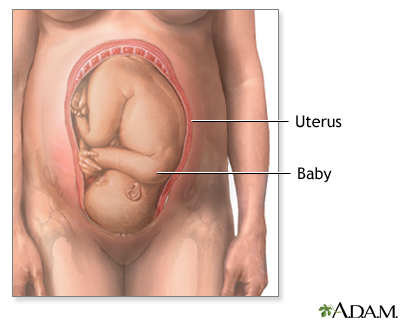Common Pregnancy Symptoms to Expect During Each Trimester
“Everything grows rounder and wider and weirder, and I sit here in the middle of it all and wonder who in the world you will turn out to be.” — Carrie Fisher…

Update your location to show providers, locations, and services closest to you.
A C-section is the delivery of a baby by making an opening in the mother's lower belly area. It is also called a cesarean delivery.
Abdominal delivery; Abdominal birth; Cesarean birth; Pregnancy - cesarean
A C-section delivery is done when it is not possible or safe for the mother to deliver the baby through the vagina.
The procedure is most often done while the woman is awake. The body is numbed from the chest to the feet using epidural or spinal anesthesia.

1. The surgeon makes a cut across the belly just above the pubic area.
2. The womb (uterus) and amniotic sac are opened.
3. The baby is delivered through this opening.
The health care team clears fluids from the baby's mouth and nose. The umbilical cord is cut. The health care provider will make sure that the infant's breathing is normal and other vital signs are stable.
The mother is awake during the procedure so she will be able to hear and see her baby. In many cases, the woman is able to have a support person with her during the delivery.
The surgery takes about 1 hour.
There are many reasons why a woman may need to have a C-section instead of a vaginal delivery. The decision will depend on your doctor, where you are having the baby, your previous deliveries, and your medical history.
Problems with the baby may include:
Health problems in the mother may include:
Problems at the time of labor or delivery may include:
Problems with the placenta or umbilical cord may include:

A C-section is a safe procedure. The rate of serious complications is very low. However, certain risks are higher after C-section than after vaginal delivery. These include:
Most of the time, a transfusion is not needed, but risk is higher.
A C-section may also cause problems in future pregnancies. This includes a higher risk for:
These conditions can lead to severe bleeding (hemorrhage), which may require blood transfusions or removal of the uterus (hysterectomy).
Most women will remain in the hospital for 2 to 3 days after a C-section. Take advantage of the time to bond with your baby, get some rest, and receive some help with breastfeeding and caring for your baby.
Recovery takes longer than it would from a vaginal birth. You should walk around after the C-section to speed recovery. Pain medicines taken by mouth can help ease discomfort.
Recovery after a C-section at home is slower than after a vaginal delivery. You may have bleeding from your vagina for up to 6 weeks. You will need to learn to care for your wound.
Most mothers and infants do well after a C-section.
Women who have a C-section may have a vaginal delivery if another pregnancy occurs, depending on:
Vaginal birth after cesarean (VBAC) delivery is very often successful. Not all hospitals or providers offer the option of VBAC. There is a small risk of uterine rupture, which can harm the mother and the baby. Discuss the benefits and risks of VBAC with your provider.



Berghella V, Mackeen AD, Jauniaux ERM. Cesarean delivery. In: Landon MB, Galan HL, Jauniaux ERM, et al, eds. Gabbe's Obstetrics: Normal and Problem Pregnancies. 7th ed. Philadelphia, PA: Elsevier; 2021:chap 19.
Hull AD, Resnik R, Silver RM. Placenta previa and accreta, vasa previa, subchorionic hemorrhage, and abruptio placentae. In: Resnik R, Lockwood CJ, Moore TR, Greene MF, Copel JA, Silver RM, eds. Creasy and Resnik's Maternal-Fetal Medicine: Principles and Practice. 8th ed. Philadelphia, PA: Elsevier; 2019:chap 46.


“Everything grows rounder and wider and weirder, and I sit here in the middle of it all and wonder who in the world you will turn out to be.” — Carrie Fisher…

December 13, 2021
UF Health Shands Hospital has been recognized as high performing among the nation’s best for high-quality, patient-centered maternity care, according to U.S.…
Department of Obstetrics and Gynecology, +3 more

Though it’s painful and exhausting, the tried-and-true method of vaginal birth is good for both mothers and babies. The American Pregnancy Association reports that a traditional delivery means...
Children born by Cesarean section before thirty-nine weeks in the womb are more likely to have immediate health...